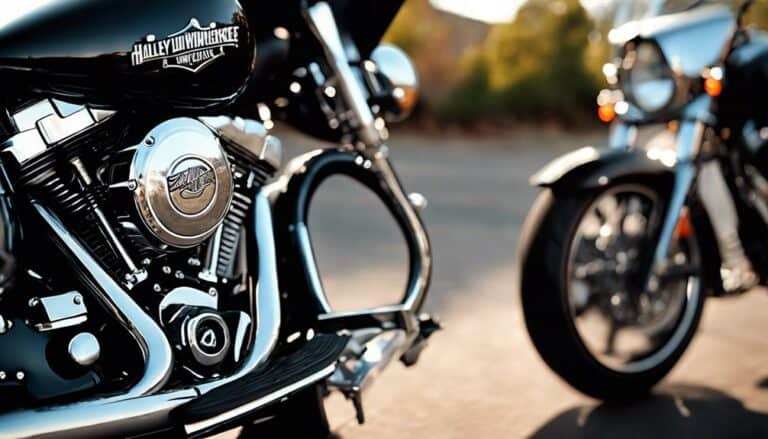When it comes to Harley-Davidson engines, it's like navigating through a museum of time-honored craftsmanship, each engine akin to a different masterpiece on display.
From the classic rumble of the Knucklehead to the refined power of the Milwaukee-Eight, every engine tells a story of innovation and performance tailored to suit distinct rider preferences.
But what sets these engines apart in terms of design, power delivery, and overall riding experience? Let's explore the intricacies that make each Harley powerplant a unique piece of the brand's legendary heritage.
Key Takeaways
- Evolution engine introduced in 1984 with 80ci capacity, marking a significant advancement in Harley's engine technology.
- Twin Cam engine, launched in 1999, surpassed the Evolution engine in terms of performance and power output.
- Revolution engine, introduced in 2001, showcased a shift towards liquid-cooled designs for improved efficiency.
- Milwaukee-Eight engine, since 2017, powers Harley's touring models with enhanced performance and reduced vibrations.
Evolution of Harley Engines
The Evolution engine, introduced by Harley-Davidson in 1984, revolutionized their lineup with increased power, cooler operation, and smoother performance compared to its predecessor, the Shovelhead. This marked a significant advancement in engine technology for Harley-Davidson, as the Evolution engine boasted an 80ci capacity and utilized Computer-Aided Design for enhanced performance and reliability. The transition from the Shovelhead to the Evolution engine brought about a notable improvement in overall performance, making it a favorite among riders seeking liberation on the road.
The Evolution engine paved the way for further innovations in Harley-Davidson's lineup, leading to the introduction of the Twin Cam engine in 1999. The Twin Cam engine featured two chain-driven cams, providing higher torque and horsepower output compared to the Evolution engine. This shift brought about enhancements in power delivery, cooling efficiency, and a more rigid connection between the engine and transmission. Notable design differences included the aluminum rocker boxes on top of the heads for Evolution engines, while Twin Cam engines sported a distinctive nose cone design and a different cam plate design.
Key Features of Early Models
Early Harley-Davidson engines, such as the Flathead and Knucklehead, prominently featured distinct design elements that set them apart from competitors in the industry. These early models were characterized by:
- Vertical Fins and Knuckle-like Balls: The Flathead and Knucklehead engines had vertical fins and protruding balls resembling knuckles, making them easily identifiable.
- No Traditional Rocker Box: Flathead engines stood out with their vertical fins, lacking the traditional Rocker Box design seen in other manufacturer's engines.
- Distinct Knuckle-like Design: Knucklehead engines, following the Flathead models, featured distinctive knuckle-like design elements that set them apart.
- Rocker Boxes: Panhead engines succeeded Knuckleheads, with Rocker Boxes resembling upside-down pans and larger rocker arm bolts similar to Knuckleheads.
- Unique Shovelhead Design: Shovelhead engines, following Panheads, featured Rocker Boxes resembling upside-down shovels, known for their performance and distinctive sound.
Transition to Modern Engine Designs
Pioneering design elements in early Harley-Davidson engines have evolved significantly, leading to the introduction of revolutionary modern engine designs that prioritize enhanced performance and functionality. The Evolution engine, introduced in 1984, marked a shift with its all-aluminium construction and enhanced components.
Following this, the Twin Cam engine in 1999 brought higher torque and horsepower, improved cooling, and a more rigid engine/transmission connection. The Revolution engine, launched in 2001, stood out with its water-cooled design, developed in collaboration with Porsche for competitive street/cruiser bikes.
The Milwaukee-Eight engine, introduced in 2017, boasts a 107-117ci displacement, offering increased torque and power. It features counter-balancing for reduced vibration and maintenance-free valve clearances, enhancing the rider's experience. These modern engine designs incorporate liquid cooling, overhead valves, and cutting-edge technology to meet the demands of riders seeking top performance in both leisure rides and competition.
Performance Upgrades Over the Years
With each successive model release, Harley-Davidson engines have undergone performance upgrades that significantly boost power output and operational smoothness. These enhancements have led to improved rider experience through increased power, torque, and smoother operation.
Advancements in technology have also focused on enhancing cooling efficiency and overall engine reliability, ensuring a more durable and efficient engine. The transition from traditional air-cooled engines to liquid-cooled ones has played a crucial role in improving performance and longevity.
Moreover, the introduction of counter-balanced engines has successfully reduced vibrations, providing a more comfortable and stable ride for the rider. Harley-Davidson's continual evolution in engine designs showcases a commitment to not only enhancing performance but also prioritizing durability and the overall satisfaction of the rider.
Comparison of Recent Engine Innovations
Recent advancements in Harley-Davidson engine technology have brought forth a new era of performance and innovation, elevating the riding experience to unprecedented levels.
The Evolution engine, with its 80ci capacity introduced in 1984, marked a significant improvement in power and smoothness over its predecessor, the Shovelhead.
The Twin Cam engine, launched in 1999, surpassed the Evolution engine in torque and horsepower, enhancing overall performance.
From 2001 to 2017, the liquid-cooled Revolution engine, a collaboration with Porsche, offered a unique V-Twin design tailored for street and cruiser bikes.
Since 2017, the Milwaukee-Eight engine has powered touring and trike models with increased torque and power while being counterbalanced to reduce vibrations.
These advancements showcase Harley-Davidson's commitment to pushing boundaries in power, cooling efficiency, and durability, providing riders with cutting-edge technology for a liberating riding experience.
Conclusion
You've now journeyed through the evolution of Harley-Davidson engines, from the classic Knucklehead and Panhead to the modern marvels like the Milwaukee-Eight.
Each engine type has brought its own unique blend of power, performance, and innovation to the table. Like a symphony of mechanical artistry, these engines have harmonized the past with the present, creating a legacy of legendary rides that continue to thrill riders around the world.

